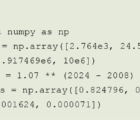Developing capital standards for insurance has been one of the most complex and detailed efforts of recent years.
Naturally, property/casualty actuaries are in the middle of it.
At the CAS 2015 Annual Meeting, a session titled, “A New Era in Regulatory Capital Standards — An Inside View on How P&C Actuaries Are Effecting Policy Change,” offered the perspectives of three CAS Fellows on several particular issues concerning the property/casualty industry.
The drive to create capital standards involves a flurry of activity on a number of fronts. The National Association of Insurance Commissioners (NAIC) is enhancing its two-decade-old standard for individual companies’ risk-based capital. It is also developing a capital calculation that would be a regulatory tool, not a standard, at the group level.
Europe is finalizing a move to its own capital standard, Solvency II.
International insurance regulators are developing standards for big international insurers and an additional standard for “globally systemically important insurers,” i.e., those whose demise could jeopardize the world economy.
The Federal Reserve Board in the United States is developing an approach to measuring capital for insurers it regulates, which includes those with thrift holding companies. Also involved is the relatively new Federal Insurance Office (FIO), a part of the U.S. Treasury Department created by the Dodd-Frank Act.
On the international stage, U.S. organizations have to coordinate efforts. The FIO, NAIC and the Federal Reserve Board — together called “Team USA”— work with the International Association of Insurance Supervisors, as that group develops an international capital standard.
The standard is meant to cover both insurance and non-insurance operations and is intended to cover both life and property-casualty operations. Ned Tyrrell, international technical policy advisor for the NAIC, said key issues include determining:
- Whether the standard will be a prescribed standard — a “soft floor” that gives regulators the option to intervene — or a minimum standard — a floor that insurers can’t fall below without regulator intervention. The international standard seems to be moving to the former, Tyrell said.
- What level of risk the measure is intended to protect against. The international standard will be such that an insurer has at most a one in 200 chance of insolvency, known as a 99.5 percent value-at-risk standard.
- What time horizon the standard is intended to protect. The international standard protects for one year, meaning that the chance of insolvency is at most a one in 200 in the next year.
The one-year time horizon, Tyrrell noted, doesn’t mesh well with the long-tailed risks in property/casualty insurance. How, he asked, does the risk of a slow-building liability calamity like asbestos fit into a one-year time frame?
Meanwhile, the U.S. actuaries have been looking at the more than two-decade-old risk-based capital standards, said Lauren Cavanaugh, an actuary and senior director with FTI Consulting. The American Academy of Actuaries provides input on solvency issues and keeps actuaries informed on proposed changes. The CAS is conducting research through its Risk-Based Capital Dependencies and Calibration Working Party.
The CAS working party developed a time-tested actuarial yardstick — actual vs. expected analysis. This working party compared the actual discounted loss plus discounted reserve runoff of companies with the underwriting risk implied by the risk-based capital formula, which is currently calibrated to an 87.5th percentile. They found that approximately 89 percent of company-year data points observed underwriting losses less than the level implied by the risk-based capital formula, an 89% safety level, Cavanaugh said. Further, for the largest companies, this safety level is higher than for the smallest companies.
The research also showed what Cavanaugh called a “minor lines effect” — in general, companies that have a very small percentage of total premium in a line of business have greater underwriting risk variability in that line.
The Academy’s Property and Casualty Risk-Based Capital Committee creates recommendations based on the information, she said, to help improve the risk-based capital formula.
David Payne, an actuary and senior manager at EY, works closely with Solvency II, the European standard scheduled to go into effect January 1, 2016.
Solvency II has similarities with the NAIC risk-based capital measure, Payne said.
Insurers have to hold enough assets to cover their best estimate of liabilities, plus a capital cushion to handle negative surprises that can arise over one year. The result is the “soft floor” that Tyrrell described. A separate calculation for the minimum standard is also present within Solvency II.
Solvency II differs from the U.S. approach to capital measurement because it offers insurers the option to use their own internal model, if the insurer receives regulatory approval. Otherwise, the insurer must follow a standard formula.
“It’s very difficult to get an internal model approved,” Payne said. Seven separate rigorous tests must be passed. Alternatively, insurers can supplant part of the standard model with their own work to arrive at a “partial internal model,” but this must also be approved.
Payne held that one notable concern involving all parties is that much of the work is relatively new. Capital standards for Switzerland, Bermuda and Australia have only been in place a few years. Solvency II and a Chinese standard take effect January 2016.
“Many of the issues being encountered are new for insurers,” Payne observed. “A lot of this hasn’t been implemented yet and there is still uncertainty around some of the rules.”
While the effort is complex, it is another example of how the actuary’s quantitative skill and intellectual rigor can help the insurance industry.
James P. Lynch, FCAS, is chief actuary and director of research and information services for the Insurance Information Institute in New York.











